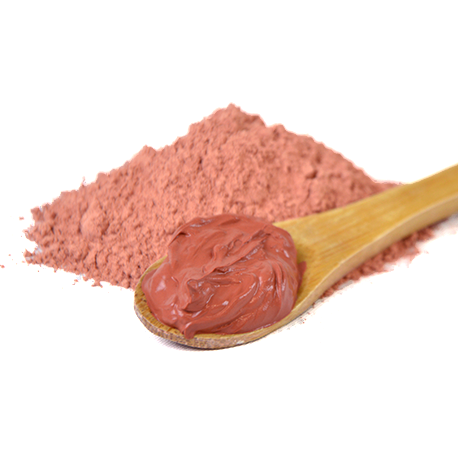La Compagnie des Sens and its teams do not encourage self-medication. The information and advice provided comes from a reference bibliographic database (books, scientific publications, etc.). They are given for information purposes, or to suggest avenues for reflection: they should in no case replace a diagnosis, consultation or medical follow-up, and cannot engage the liability of the Compagnie des Sens.

Illite type red clay is a very absorbent and adsorbent clay. Its color provided by its richness in iron oxide gives it mattifying properties, revealing a healthy glow but also circulatory and decongestant. It will be ideal for blotchy skin prone to redness. As a mask, red clay revives dull skin and restores strength and shine to dark hair. For uses in clay therapy, we will limit ourselves to external use as a poultice. INCI name: Illite and Kaolin. Origin: France.
This article was updated on 26/01/2024Methods of using clays
In cosmetic care
- Mask for skin or hair;
- Exfoliating treatment;
- Mudbath.
In therapeutic care
- Poultice;
- Clay water;
- Clay water.
For skin prone to redness and blotchiness
Known to improve blood circulation thanks to its composition rich in iron oxide, Red Clay is ideal for skin prone to redness and blotchy skin. It will help soothe the skin, mattify it and give a boost of radiance to the complexion.
-
Use as a mask: make a clay paste to apply directly to the skin as a mask, once a week for 10 to 15 minutes, ensuring that the Red Clay does not dry out.
-
Complementary essential and vegetable oils: incorporate into your preparation a teaspoon of soothing vegetable oil such as Calophyll Inophyle oil and 3 drops of Italian Helichrysum essential oil. After rinsing, massage your skin with vegetable oil.
For dull and tired skin
Rich in trace elements and promoting blood circulation, Red Clay is very useful in skin care and will help revive the radiance of the skin and brighten the complexion. Cleansing and particularly absorbent, it will also regulate excess sebum and will therefore be suitable for oily to combination skin.
-
Use as a mask: make a clay paste to apply directly to the skin as a mask, for 5 minutes. You can make this mask whenever you feel the need.
-
Complementary hydrosols and vegetable oils: for more effectiveness, you can incorporate Ginger hydrosol, oily Carrot macerate or even Apricot Kernel oil.
For dark and red hair
With its red color, this clay is particularly suitable for dark, brown and red hair. Thanks to its purifying and absorbent properties, Red Clay also helps eliminate impurities while regulating excess sebum to add shine to the hair.
-
Use as a mask: make a clay paste to distribute over the entire scalp using a massage. Leave on for 15 minutes and rinse with clean water.
-
Complementary essential and vegetable oils: to bring pretty highlights to your hair, Cinnamon, Rosemary, Cineole or Lemon essential oils can act as natural lighteners. Argan and Apricot Kernel vegetable oil will nourish and protect the hair.
Against tHE wrinkles
Red Clay is suitable for the care of mature skin and particularly for the treatment of wrinkles. Rich in minerals and trace elements, it will cleanse and detoxify the skin to promote cell renewal.
-
Use in cream: make a clay paste using a teaspoon of Red Clay then Shea butter and Rosehip vegetable oil until you obtain a homogeneous paste. Apply directly to the skin in the evening.
-
Complementary essential oils: for more effectiveness, you can add 3 drops of Rosat Geranium essential oil.
Main properties of Red Clay
- Absorbent, cleaning, adsorbent: illite red clay is, like green clay, particularly absorbent. It is therefore suitable for cleansing combination to oily skin. It allows you to capture a good number of impurities, bacteria and other parasites on the skin and hair. Its properties allow cleansing of the skin and absorption of excess sebum.
- Exfoliating: the powdery appearance of the clay and its granulometry give it cleansing and exfoliating properties ideal for skin scrubs.
- Colorant: its natural coloring gives it interesting coloring properties, particularly for dark skin and dark and red hair. It is also possible to use it as makeup on the cheeks for a healthy glow.
- For oily to combination skin: illite red clay is recognized for its cleansing and particularly absorbent properties allowing it to regulate excess sebum. It is therefore suitable for oily to combination skin.
- For sensitive and blotchy skin: the color of red clay gives it mattifying properties and its composition rich in iron oxide allows it to fight against rosacea via its circulatory action.
- For dark and red hair: due to its color, red clay is more suitable for dark, brown and red hair. Its purifying and absorbent properties help eliminate impurities and excess sebum while mattifying and leaving hair shiny.
Characteristics and composition

Cosmetic features
- Skin type: all skin types, but special mention for sensitive, dull and mature skin
- Hair type: all hair types, but particularly suitable for dark and red hair

Mineralogical characteristics
- INCI name: Illite and Kaolin
- Country of origin: France

Physical characteristics
- Humidity: <8%
- Particle size: 90% < 100 μm / 100% < 150 μm
- pH: 8 to 9
- CEC: 20 meq/100 g

Organoleptic characteristics
- Appearance: superfine powder
- Color: orange-red
- Odor: odorless

Composition
- Illite: 75% ± 5
- Kaolin: 25% ± 3
- Quartz: none
- Pb < 15 ppm
- Ace < 15 ppm
- CD < 0.2 ppm
- Hg < 0.05 ppm
Precautions for use
-
Ingestion, people subject to constipation should not use clays. Their use is also contraindicated in people with a digestive hernia, in cases of high blood pressure, a history of intestinal obstruction or even nausea. Be careful, ingesting clay can counteract the effects of drug treatments. It is important to drink enough water during a clay treatment.
-
Dermal, clay should not be reused, be sure to throw away clay that has already been used. Avoid letting it dry a clay. Rinse with clean, cold or lukewarm water. On the hairiest parts of the body, for maximum comfort, place a compress between the clay poultice and the skin.
-
When handling, be careful of drafts as the clay is powdery. It should not be inhaled. In case of excessive inhalation, it is important to get fresh air. In case of contact with eyes or mucous membranes, rinse with plenty of water. Be careful, when handling clays, do not use metal utensils, they will lose a large part of their effectiveness.
-
Pregnant and breastfeeding women and young children should seek medical advice before use.
-
Store preferably in a dry place, away from light and heat.
Was this article helpful to you?
Average grade: 4.7 ( 203 votes)
Bibliography
Publication: Carretero, M.I. (2002). Clay minerals and their beneficial effects upon human health. A review. Applied Clay Science, 21(3-4), 155-163.
Publication: Hernot, F. (2006). Clay, its use in the pharmacy. http://dune.univ-angers.fr/fichiers/20073109/2016PPHA5426/fichier/5426F.pdf
Work : Dextreit, R. (2010). The clay that heals: a guide to natural medicine. Escalquens, France: Living in harmony.
Work : Baudet, C. (2012). In shape thanks to clay! : Natural health and well-being. Mens, France: Terre Vivante Editions.
Website : https://www.rglayduvelay.com/fr/
Related articles
GUIDE The benefits of Red Clay for the face and skin
GUIDE How to reduce rosacea with Red Clay?


